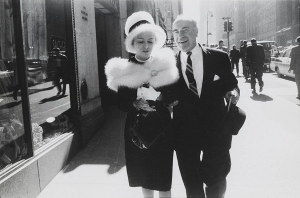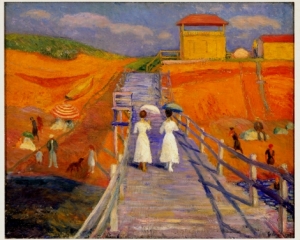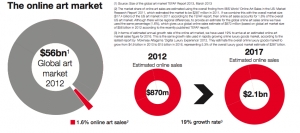|
Displaying items by tag: survey
A survey has found that support for the Guggenheim’s Helsinki project is weak among city councilmembers in the Finnish capital, raising questions about the financial future of the museum’s latest global outpost. The January 16 questionnaire, published by the Yle newspaper, found that 39 of 68 city councilmembers polled either do not support the Guggenheim Helsinki at all or object to the provision of public funds to the Guggenheim. These findings follow contentious public discussions of the funding for the Helsinki franchise in Finland, most recently in June 2014, when Guggenheim director Richard Armstrong walked out of an interview after being asked pointed questions about the project’s budget.
New studies released today by the National Endowment for the Arts (NEA) and based on surveys carried out in 2012 claim that arts attendance in the US has continued to drop over the past two decades, but both struggle to incorporate digital activities into their findings. The studies, “A Decade of Arts Engagement: Findings From the Survey of Public Participation in the Arts, 2002–2012” and “When Going Gets Tough: Barriers and Motivations Affecting Arts Attendance,” break down arts attendance, participation, and production figures demographically and attempt to account for the reasons certain groups do and don’t attend cultural events.
With over 100 works generously loaned from 30 collections, the Stedelijk Museum presents "The Oasis of Matisse" next spring. For the first time in over sixty years, the work of the French master will go on view in the Netherlands. Never before have so many of his works been on show in this country.
The Stedelijk has conceived a unique exhibition concept for this survey: the permanent collection on the museum’s ground floor will be enriched with a selection of Henri Matisse’s (1868-1854) classic pieces, creating surprising combinations with the work of his contemporaries, teachers, and followers. In this way, both the work of one of the most important artists of the twentieth century as well as other artists can be seen in a new light, and visitors will be able to encounter Matisse’s art at every stage of his artistic development.
Only a quarter of Britons believe that the Elgin Marbles, the ancient sculptures that once decorated the Parthenon temple in Athens, should remain in London's British Museum, according to a poll published Tuesday.
Half of the respondents to the YouGov survey published in the "Times" said the artifacts, also known as the Parthenon Marbles, should be returned to Greece, with a quarter undecided.
But a slim majority backed the museum's controversial decision to loan the works, which were taken from the Parthenon by British diplomat Lord Elgin in 1803, to Russia's State Hermitage Museum.

Visitors to The Metropolitan Museum of Art’s presentation of four special exhibitions during the spring/summer 2014 season—"Lost Kingdoms: Hindu-Buddhist Sculpture of Early Southeast Asia, 5th to 8th Century;" "The Roof Garden Commission: Dan Graham with Günther Vogt;" "Charles James: Beyond Fashion;" and "Garry Winogrand"—generated an estimated $753 million in spending in New York, according to a visitor survey released by the Museum today. Using the industry standard for calculating tax revenue impact, the study found that the direct tax benefit to the City and State from out-of-town visitors to the Museum totaled some $75.3 million. (Study findings below.) 53% of the out-of-town exhibition visitors reported that visiting the Met was a key motivating factor in their decision to visit New York.
Thomas P. Campbell, Director and CEO of the Metropolitan Museum, noted: “As this annual survey continues to indicate, the Met’s stellar range of exhibitions, as well as its renowned collection, are recognized world-wide for their excellence, and continue to draw domestic and international visitors to New York in large numbers. This visitorship plays a vital role in the City’s cultural tourism, which is a powerful contributor to the economic well-being of New York.”
A window on the private world of China’s Ming and Qing emperors opens october 18, when some 200 works — portraits, costumes, and palace furnishings such as bronzes, lacquerware, and jade—drawn from the holdings of the Palace Museum in Beijing go on view at the Virginia Museum of Fine Arts. The exhibition surveys the seminal role of imperial rituals and religion in the Forbidden City, along with hidden aspects of court life from the mid 14th through early 19th centuries.
Art Basel in Miami Beach has just released details about Survey, its brand new section devoted to “art-historical projects” (read: art that was made a few decades ago). The thirteen projects cover quite a bit of ground, ranging from a group show of female geometric abstractionists to a solo presentation of Chilean political artist Lotty Rosenfeld.

From July 20 through October 13, the Parrish Art Museum presents William Glackens—the first comprehensive survey of the artist’s work since 1966. The exhibition spans Glackens’s career from the 1890s through the 1930s, with more than 70 important paintings and works on paper from some of America's finest private and public collections, including the Metropolitan Museum of Art, Fine Arts Museum of San Francisco, the National Gallery of Art, and the Cleveland Museum, among others. Several works in the exhibition are on view to the public for the first time since 1966.
William Glackens, co-organized and presented by the Parrish Art Museum; Nova Southeastern University Museum of Art | Fort Lauderdale (where it was on view earlier this year); and the Barnes Foundation, Philadelphia (where the exhibition will also travel), spans the full career of the artist, who painted on Long Island from 1911–1915. Curated by writer and art historian Avis Berman, the exhibition focuses on Glackens’s most distinctive and adventurous works.

The Online Art Trade Report by the British insurance group Hiscox estimated the value of global online art sales at $1.6 billion in 2013, up from $870 million in 2012. The report’s findings are based on a survey of 506 international art buyers, collectors, and galleries from a database belonging to ArtTactic, an organization that specializes in art market research and analysis. The study estimated that the online art market will grow to $3.8 billion by 2018.
According to the report, 71% of art collectors surveyed have purchased artwork without seeing it in person first and 89% of the galleries surveyed claimed that they regularly sell to clients using a digital image only. Nearly 25% of 20- to 30-year-olds surveyed said that they had purchased art online and nearly half of the collectors over 65-years-old surveyed said that they had bought art directly online.
Robert Read, Hiscox Global Head, Fine Art, said, “This research distills the views of collectors, galleries and the greater art community and it tells us that trading online is now an established and accepted way to buy and sell art. Increasing accessibility can only be a good thing, and we are seeing new players coming into the market from a range of territories, at all ages and price points, which is an exciting – if somewhat unexpected – development."
According to the report, online art sales account for 2.4% of the estimated value of the global art market, which in 2013 was $65 billion.
Click here for the full report.

In November 2012, two members of the Metropolitan Museum of Art in New York sued the institution for deceiving the public by making patrons think that the suggested admission fees are mandatory. The historically free institution suggests entry fees of $25 for adults and less for seniors and students.
Theodore Grunewald and Patricia Nicholson files the suit in state court in Manhattan and said that the museum’s fee policy lacks transparency. They also argued that the museum fails to note that the fee is suggested on several of its websites and that it’s only in fine and barely legible print on signs near cash registers. A statute was put in place in 1893 declaring that the Met must remain free in order to continue receiving government funding. Grunewald and Nicholson commissioned a survey of visitors to the museum and found that 85% of patrons believed they had to pay to gain entry.
According to court papers filed by Gerald Lee Jones, who worked at the Met as a floor manager from 2007 until 2011, cashiers were trained to deceive visitors and they were paid in part based on how much they collected from admission fees. The statement, which was filed in late June 2013, also suggested that cashiers were instructed to never volunteer that patrons may pay less than the “recommended” fee.
During the year ending in June 2012, the Met brought in $37.8 million in admissions, about 16% of the museum’s revenue.
|
|
|
|
|